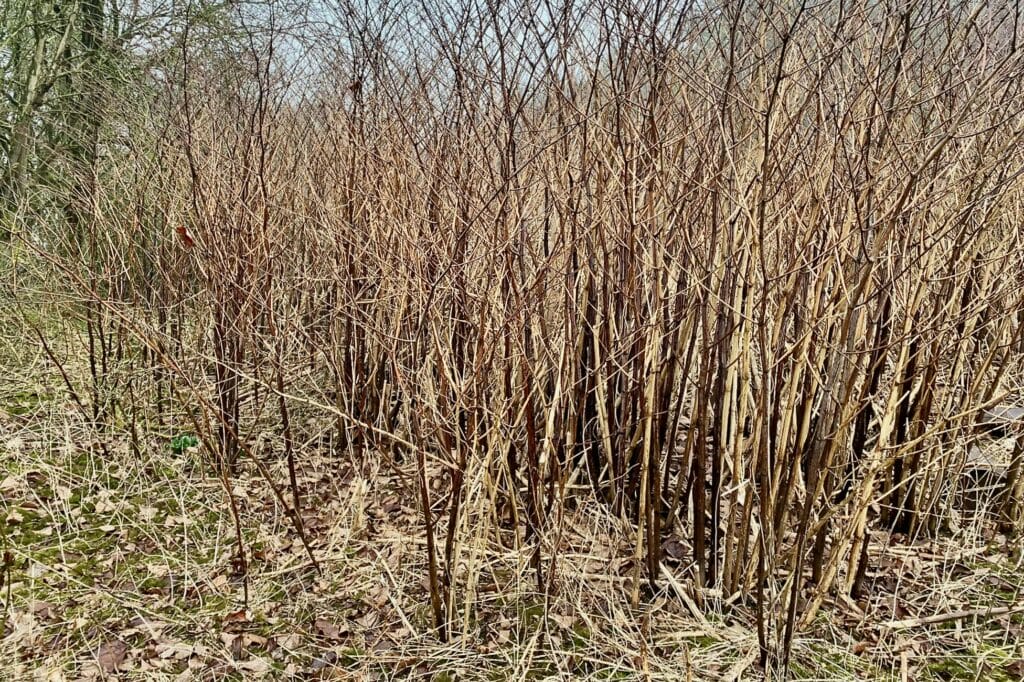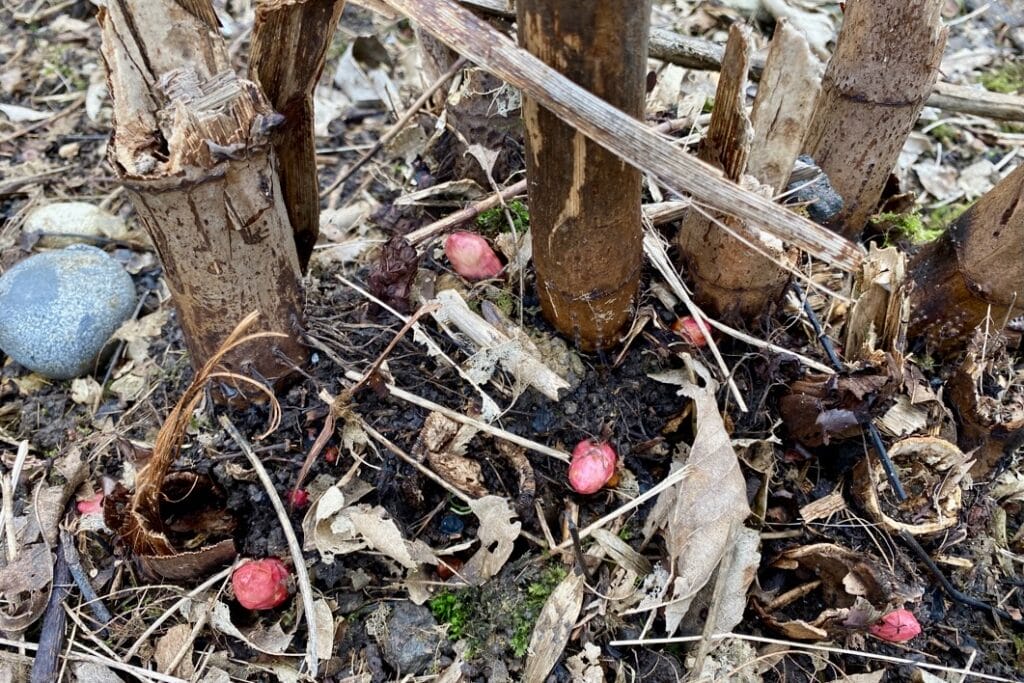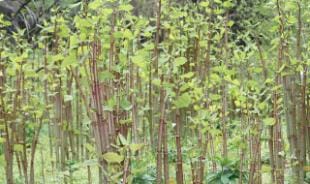The striking appearance of knotweed fades after the autumn, making winter identification of Japanese knotweed more challenging. Recognising the UK’s most notorious invasive plant during the coldest months requires an understanding of its distinct features. Certain characteristics, Japanese knotweed winter canes and knotweed crown, remain visible. Pictures better illustrate other, more subtle winter knotweed traits. What happens to a Japanese knotweed plant in winter has the biggest bearing on identification. It also provides explanation to frequently posed questions concerning whether knotweed continues to grow or dies in winter.
Whether knotweed is in an urban or rural setting, understanding seasonal characteristics is important for informed decision-making. This guide explains key elements necessary to identify Japanese Knotweed during the winter in the UK.
What does Japanese knotweed look like in winter?
Throughout winter, Japanese knotweed still exhibits distinctive features. However, to identify the plant between December and February, closer examination is needed. A noteworthy characteristic to look for is the distinctive zigzag stem. They can bee seen extending upward from brittle and hollow, brown canes that resemble dark bamboo. For at least part of the winter, they may still also still exhibit the crumbly remnants of flower clusters. Though, without these present (and with no leaves) it’s easier to see the zigzag shape.
Taking a physical approach to identifying knotweed in winter requires caution to prevent its unintentional spread. If you are examining a plant you suspect of being knotweed, It is critical to clear mud and vegetation from boots before moving to a new location. Thoroughly check clothing for any plant fragments, ensuring you leave them where they originated. Then you can focus on looking for knotweed’s key winter identifiers:
Knotweed Canes
Despite the plant’s winter dormancy, Japanese knotweed winter canes maintain a persistent and recognisable presence. The dried, tan-brown canes stand between 1-3 metres in height, with ring nodes like those of bamboo. You can sometimes see knotweed canes covering a large area, when the plant has been allowed to establish itself. They provide the best identification clue during the dormant season. Remnants of knotweed canes from multiple seasons, can even provide experts with an indication of the plant’s age.

Dense Japanese knotweed winter cane stand
Knotweed Crown
The crown sits on the surface between the canes and the below-ground Japanese knotweed rhizomes. The knotweed crown stores carbohydrates that will be needed by the plant for the next growing season. New growth will emerge from here, and develop into young knotweed shoots in the spring. During winter inspection, the crown provides an identification marker even once the canes have been removed. Winter is an opportune time to inspect the crown, which may exhibit buds that are the start of new shoots. Professional assessment of the knotweed crown can offer an indication of the plant’s health.

Mature, established knotweed crown & cane fragments

Japanese knotweed crown beside a garden fence
What happens to Japanese knotweed in winter?
Japanese is a perennial plant; it can not only survive multiple growing seasons but could also remain dormant for several years. Knotweed crown and rhizome material will also remain dormant for the winter period (dependent on climate). Above-ground knotweed plant material acts as follows in the winter:
Decay of Aerial Growth
During winter, the above-ground growth of Japanese knotweed dies back. The distinctive shield-shaped green leaves, wither and turn brown as the plant enters a dormant phase.
Hollow Stems
The canes of Japanese knotweed become hollow in winter. As the plant’s energy is redirected to its rhizomes beneath the surface, the above-ground stems lose their vitality, becoming brittle as winter proceeds.
Absence of Leaves
In the latter part of winter few or no leaves will be present. The deciduous leaves drop, leaving behind the skeletal structure of the stems.
Urban Settings
Winter knotweed stands in urban settings are unappealing. Frequently, among the fallen and decaying leaves, wind-blown and fly-tipped rubbish can be found clustered in and around the knotweed canes. This mixture of plant and waste debris can also hinder treatment if not dealt with.

Winter knotweed canes which have retained dried flowers

Winter knotweed canes that have grown up inside a wall cavity
Rural Infestations
In rural areas, infestations of Japanese knotweed may contain less waste, but they present an environmental challenge. Japanese knotweed disrupts local ecosystems and can contribute to erosion along riverbanks. Winter floods can further compound this issue. Japanese knotweed rhizome fragments can get transported downstream to new locations.

Cut winter knotweed canes in a rural setting
Does Japanese knotweed grow in winter?
Japanese knotweed experiences a period of dormancy during a UK winter. Despite this, underground rhizomes remain active, serving as storage organs that preserve energy. The plant will be ready to initiate new growth when conditions become favourable. Japanese knotweed typically exhibits limited above-ground growth during winter due to colder temperatures and reduced sunlight.
Winter germination
In certain instances, Japanese knotweed defies the winter dormancy tag. In response to a mild UK winter germination can take place. When this occurs, it is normally towards the end of the winter in response to warm weather, and when winter temperatures have remained warmer.

The winter germination of Japanese knotweed
How do you know if knotweed is dead?
Japanese knotweed is a famously resilient plant that, in its native Japan, exists on the side of volcanos. Any presumption that the plant is dead is likely to be inaccurate. Even with dead, or removed, above-ground plant material the rhizomes could remain dormant for up to 20 years.
Disintegration of the crown, stems and a general lack of structural integrity could provide a visual cue that the plant is no longer viable. However, Japanese knotweed is capable of regenerating from just a small portion of viable rhizome, so even this can be deceptive.

Decaying knotweed crown and canes
Determining whether Japanese knotweed is actually dead, should be only carried out by a professional. They will do this by a combination of visual observation and, in some cases trial digs may be required to assess the health of the plant’s rhizome.
It should be noted, any attempt to do this without the required training and expertise could result in dispersing knotweed. Several high-profile Japanese knotweed legal cases have result from allowing knotweed to spread to neighbouring properties without intervening.
PBA Solutions undertakes site surveys to determine if Japanese knotweed is present. Even during the winter months, our experienced surveyors can assess, document and report the findings. You can book a Japanese knotweed survey here. A Japanese knotweed survey will provide formal identification, an accurate record of where the knotweed is located and the most appropriate methodology for control or removal.
If you are concerned about the presence of winter knotweed, call and talk to a member of our team on 0203 174 2187 or 01202 816134.
All pictures © 2023 PBA Solutions




